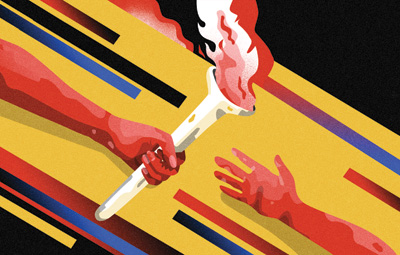Sign up for The Media Today, CJR’s daily newsletter.
I’ve often been puzzled by why young people just starting out would willingly veer toward the profession of journalism. Decent jobs are hard to come by, and for those who land one, the first paycheck will surely be a disappointment. The J-school grads will be buying used shoes on eBay while their MBA friends are paying full price for anything Canada Goose.
So when I was invited to teach a class at Columbia University’s Graduate School of Journalism, I approached with both respect for my prospective students and curiosity about their life choices. The class was a seminar of 14 students and this was their assignment: Put out the May/June issue of CJR’s print magazine along with a companion website designed by your fellow classmates and filled with everyone’s content. This was no test run. No academic exercise. It was game on.
What you’re looking at now is their final exam. It’s also the first student edition of CJR, at least to anyone’s recollection around here. There weren’t many rules about what the students could do, except that it had to be about journalism. So after much discussion, some debate, and a vote, the class came up with the idea of making the magazine all about one subject: experimental journalism. Whether individual students wrote a story, shot a video, or recorded a podcast, the dominant theme was to explore the front edge of journalism, the world of experimentation, whether by old media or new.
Among the stories is one by Tariro Mzezewa, who asks the question of whether it is possible to get millennials to watch network news. You may think not, given how few people in their 20s and early 30s even own a television, but CBS is aiming to break into that market with a product that ditches the TV altogether.
Student Jack Murtha wrote about how a man in England appeared to have died twice on the internet. The confusing saga was the result of an errant tweet and algorithms that determine what content appears on social media feeds. Together the two created a hyper state of confusion over the death of a legendary man who had long since passed away. A story of new media if there ever was one.
Danny Funt brings it closer to home, writing about the shifting priorities of journalism schools across the country, and asks whether the pendulum has swung too forcefully toward digital and away from basic skills like good writing.
We were grateful to have some video talent among the class, something CJR has scarcely any of on staff now. Kay Thao Nguyen produced a short documentary about the last decade of online video journalism with three questions in mind: What were these films trying to achieve? Who was doing them? And how did they turn out?
Tom Davis also made CJR a little bit cooler by producing a podcast of conversations between him and two people experimenting in do-it-yourself publishing. One person runs Handwrytten.com, which takes your typed message and turns it into a handwritten note in the style of your choice. Tom also interviews the owner and operator of Infoactive.co, a web app that helps people turn live data into interactive infographics.
The centerpiece of the issue is a list of the Top 11 journalism experiments that the class identified as the ones to watch. What I noticed, and admired, about their list is that it wasn’t just a collection of what’s cool out there. It’s a collection of what’s actually worthwhile, and creative, and forcing us to rethink what we do.
The most interesting thing I’ve noticed about my students over the course of this semester is how much they sound like I might have sounded when I was about to graduate. What inspires them to want to be a journalist is what inspires me to be in journalism. They may want to tell stories in different ways, but their values are no different than mine. Best of all, they know things I don’t. And that’s a good thing.
Has America ever needed a media defender more than now? Help us by joining CJR today.



